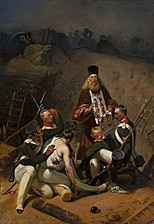Horace Vernet
| ||
 Horace Vernet | ||
| Data i miejsce urodzenia | 30 czerwca 1789 Paryż | |
| Data i miejsce śmierci | 17 stycznia 1863 Paryż | |
Horace Vernet (ur. 30 czerwca 1789 w Paryżu, zm. 17 stycznia 1863 tamże) – francuski malarz i grafik.
Życiorys
Syn Antoine'a Charles'a Horace'a Verneta. Studiował pod okiem swego ojca i Jean-Michela Moreau.
Przeciwstawił klasycyzmowi Davida swój naturalizm. Malował wielkie bitwy napoleońskie, liczne obrazy historyczne, sceny wojskowe, batalistyczne, myśliwskie i portrety. Był dyrektorem Akademii Francuskiej w Rzymie. Wykonał też liczne litografie i drzeworyty, ilustrujące książkę L. de l'Ardèche'a Historia Napoleona (1839).
W swej szkole w Rzymie wykształcił wielu polskich artystów, w tym Januarego Suchodolskiego i Józefa Brodowskiego. Był ojcem chrzestnym Wojciecha Kossaka.
Zmarł w Paryżu i został pochowany na Cmentarzu Montmartre w Paryżu.
Ważniejsze prace
- Bitwa pod Hanau, National Gallery w Londynie
- Bitwa pod Isly,
- Bitwa pod Jammages (ogromny obraz batalistyczny znajdujący się w Wersalu),
- Bitwa pod Jeną,
- Bitwa pod Somosierrą, Muzeum Narodowe w Warszawie
- Bitwa pod Wagram,
- Bitwa pod Valmy,
- Ksiądz błogosławiący żołnierzy, Muzeum Narodowe w Warszawie
- Studium męskiej głowy, Muzeum Narodowe w Warszawie
- Śmierć księcia Józefa Poniatowskiego,
- Targ niewolników,
- Żołnierz spod Waterloo,
- Wincenty Krasiński w wąwozie (1816),
- La Barrière de Clichy (1820), Luwr, Paryż
- Mazepa (1826),
- Polski Prometeusz (1831), Biblioteka Polska w Paryżu
- Włoscy bandyci zaskoczeni przez papieskie wojska (1831), Walters Art Museum, Baltimore
- Ballada o Lenorze (1839),
- Juda i Tamar (1840), Wallace Collection, Londyn
- portrety Napoleona I, Napoleona III i innych.
- Obrazy Verneta
Bitwa pod Hanau, National Gallery w Londynie
Bitwa pod Somosierrą, Muzeum Narodowe w Warszawie
Juda i Tamar (1840), Wallace Collection, Londyn
Ksiądz błogosławiący żołnierzy, Muzeum Narodowe w Warszawie
Polski Prometeusz (1831), Biblioteka Polska w Paryżu
Włoscy bandyci zaskoczeni przez papieskie wojska (1831), Walters Art Museum, Baltimore
Bibliografia
- Andrzej. Dulewicz: Słownik sztuki francuskiej. Warszawa: Wiedza Powszechna, 1986, s. 424-425. ISBN 83-214-0048-5.
- ISNI: 0000 0001 2123 5923
- VIAF: 22149840
- ULAN: 500024243
- LCCN: n82070688
- GND: 118804243
- LIBRIS: 42gkqbjn2122z96
- BnF: 11928026w
- SUDOC: 027305317
- NKC: mzk2009510494
- BNE: XX1519820
- NTA: 071085432
- Open Library: OL2299631A
- PLWABN: 9810573462805606
- NUKAT: n99036474
- PTBNP: 242371
- CANTIC: a11691360
- CONOR: 143418979
- ΕΒΕ: 144070
- WorldCat: lccn-n82070688
Media użyte na tej stronie
Horace Vernet
Battle of Hanau (30-31 October 1813), took part between Austro-Bavarian forces and French forces. This scene illustrates the attack of the Austro-Bavarian cavalry charging the French Grand Battery. Commanding the French Grand Battery is General Antoine Drouot (depicted on the right side of the painting, with an Austrian cavalryman meaning to strike him down). It also illustrates the French Guard cavalry countercharging the enemy cavalry, with its commander, General Nansouty (illustrated on the left-centre of the painting, with his back to the viewer) directing operations.
In this scene, papal troops intercept brigands who are looting a coach and carrying off its passengers. During the 19th century, brigands, or "banditi," posed a real threat to travelers in rural areas of the Italian states, but they were also idealized as daring outlaws. Horace Vernet, the director of the Académie de France in Rome (1828-34) and professor at the École des Beaux-Arts in Paris (1835-63), was regarded as a leader of the "juste-milieu," or the middle course between the opposing Romantic and Neoclassical factions in French painting. He chose dramatic, often contemporary, subjects but rendered them with the smooth brushwork and attention to detail associated with the Academic tradition.
Autor: Horace Vernet , Licencja: CC BY 3.0
Battle of Somosierra 1808 by Horace Vernet














